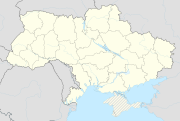Pluhiw
| Pluhiw | ||
| Плугів | ||

|
|
|
| Basic data | ||
|---|---|---|
| Oblast : | Lviv Oblast | |
| Rajon : | Zolochiv Raion | |
| Height : | no information | |
| Area : | 2.949 km² | |
| Residents : | 809 (2001) | |
| Population density : | 274 inhabitants per km² | |
| Postcodes : | 80746 | |
| Area code : | +380 3265 | |
| Geographic location : | 49 ° 45 ' N , 25 ° 2' E | |
| KOATUU : | 4621885206 | |
| Administrative structure : | 1 village | |
| Address: | вул. Зелена 11 80744 с. Підлипці |
|
| Statistical information | ||
|
|
||
Pluhiw ( Ukrainian Плугів ; Russian Плугов Plugow , Polish Płuhów ) is a village in the western Ukrainian Lviv Oblast with about 810 inhabitants.
With 7 other villages it belongs to the district council of Pidlypzi ( Підлипці ).
history
The place was mentioned in a document in 1477 as Pluhow and later as Pluchow (1483, 1515, 1578). The name is derived from the Ukrainian word for plow .
It initially belonged to the Lviv region in the Ruthenian Voivodeship of the aristocratic republic of Poland-Lithuania . During the first partition of Poland in 1772 the village became part of the new Kingdom of Galicia and Lodomeria of the Habsburg Empire (from 1804).
In 1900 the municipality of Płuhów had 188 houses with 1211 inhabitants, of which 1020 were Ruthenian-speaking, 187 were Polish-speaking, 1014 were Greek-Catholic, 119 were Roman-Catholic, 75 were Jews and 3 were of other faith.
After the end of the Polish-Ukrainian War in 1919, the community became part of Poland. In 1921 the municipality of Płuhów had 227 houses with 1208 inhabitants, of which 915 were Ruthenians, 275 Poles, 18 Jews (nationality), 1036 Greek Catholics, 134 Roman Catholics, 36 Jews (religion).
In the Second World War , the place belonged first to the Soviet Union and from 1941 to the General Government , from 1945 back to the Soviet Union, now part of the Ukraine .
Bronisławówka and Kazimirówka
In 1836, Count Mizipotowski settled German colonists on the grounds of the village. Two settlements arose: Bronisławówka and Kazimirówka (named after the count's sons), which became an independent municipality with the name Bronisławówka . As early as 1838, the Protestants founded two Lutheran subsidiary congregations of the Lemberg parish in the Evangelical Superintendentur AB Galicia .
In 1900 the Bronisławówka community had 55 houses with 376 inhabitants, including 312 German-speaking, 40 Polish-speaking, 24 Ruthenian-speaking, 28 Greek-Catholic, 11 Roman-Catholic, 24 Jews, 313 of other faiths.
In 1921 the community Bronisławówka had 41 houses with 338 inhabitants, including 149 Germans, 127 Poles, 62 Ruthenians, 167 Protestants, 117 Greek Catholics, 42 Roman Catholics, 12 Jews (religion).
The place was destroyed by Soviets in 1950.
Attractions
- Greek Catholic Church, built in 1715
Web links
- Płuhów al. Płuchów, rus. Płuhiw, z Płuchowczykiem i Bronisławówka z Kazimierówką, dwie wsie, pow. złoczowski . In: Filip Sulimierski, Władysław Walewski (eds.): Słownik geograficzny Królestwa Polskiego i innych krajów słowiańskich . tape 8 : Perepiatycha – Pożajście . Walewskiego, Warsaw 1887, p. 327 (Polish, edu.pl ).
- Memories of the former Bronislawówka in Galicia (Ukraine) (PDF; 734 kB). Aid Committee of the Galiziendeutschen eV Publication from November 2012. Accessed on December 18, 2016.
Individual evidence
- ^ Anna Czapla: Nazwy miejscowości historycznej ziemi lwowskiej [The names of the localities of the historical Lviv country] . Towarzystwo Naukowe Katolickiego Uniwersytetu Lubelskiego Jana Pawła II, Lublin 2011, ISBN 978-83-7306-542-0 , p. 149-150 (Polish).
- ↑ Ludwig Patryn (Ed.): Community encyclopedia of the kingdoms and countries represented in the Reichsrat, edited on the basis of the results of the census of December 31, 1900, XII. Galicia . Vienna 1907.
- ↑ Główny Urząd Statystyczny: Skorowidz miejscowości Rzeczypospolitej Polskiej. Województwo tarnopolskie . Warszawa 1928 (Polish, online [PDF]).
- ↑ Schematism of the Evangelical Church in Augsb. and Helvet. Confession in the kingdoms and countries represented in the Austrian Imperial Council . Vienna 1875, p. 215-218 ( online ).
- ↑ Ludwig Patryn (Ed.): Community encyclopedia of the kingdoms and countries represented in the Reichsrat, edited on the basis of the results of the census of December 31, 1900, XII. Galicia . Vienna 1907.
- ↑ Główny Urząd Statystyczny: Skorowidz miejscowości Rzeczypospolitej Polskiej. Województwo tarnopolskie . Warszawa 1928 (Polish, online [PDF]).
- ↑ Grzegorz Rąkowski: Przewodnik po Ukrainie Zachodniej. Część III. Ziemia Lwowska . Oficyna Wydawnicza "Rewasz", Pruszków 2007, ISBN 978-83-8918866-3 , p. 403 (Polish).

